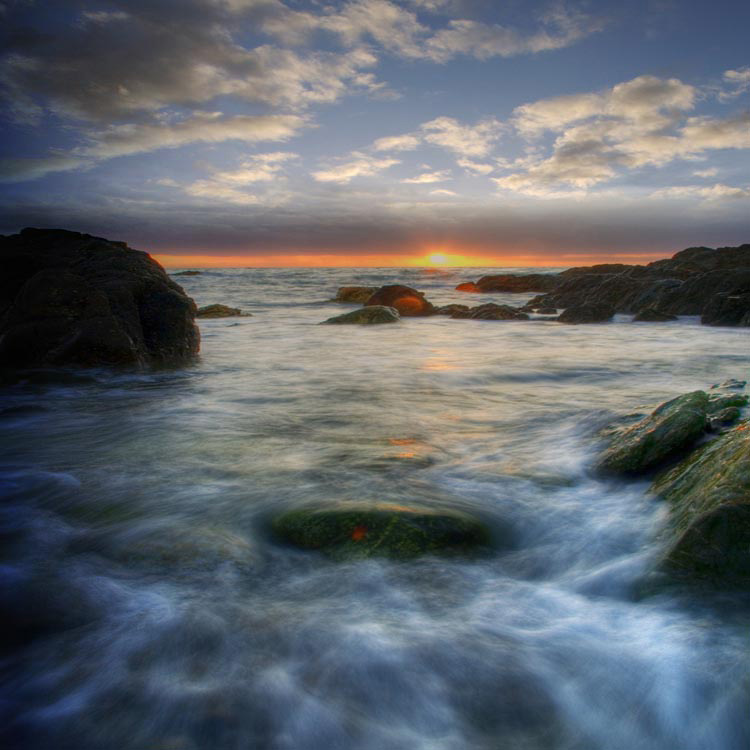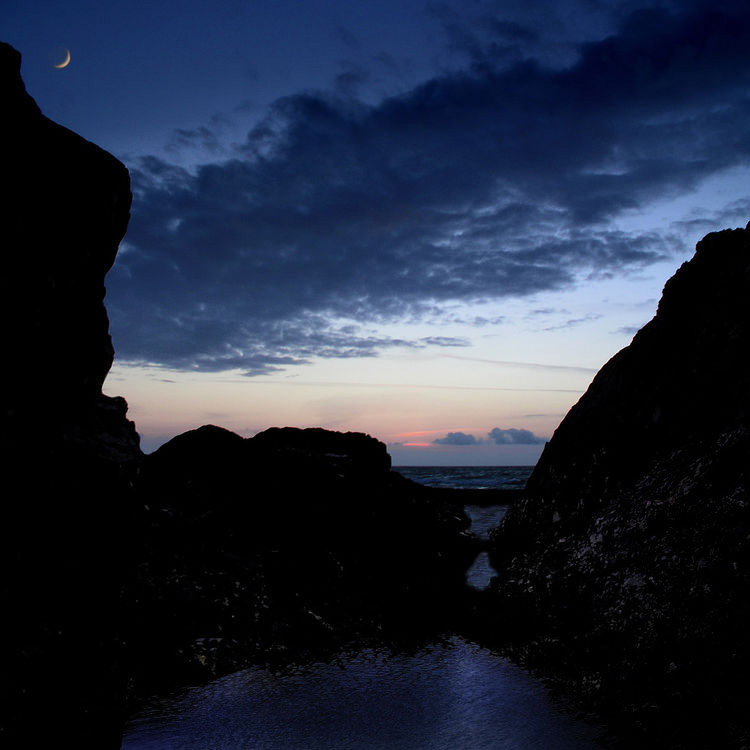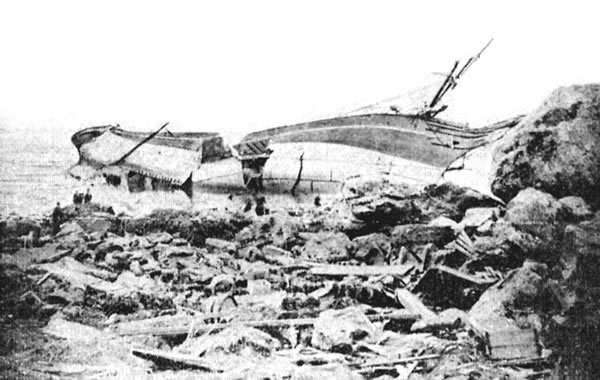Dunahoo 1814 Villa 1856Sorrento 1870William 1891 Stuart 1901 Colonel Gamble 1914
Dunahoo 1814
It was at Porth Baco in 1814 that the “Dunahoo” was wrecked with the loss of some of it’s crew. The Captain was buried on the top of the cliff. It is is said that one of the seamen jumped onto the grave saying – “It isn’t for your kindness that you are resting there.”
Villa 1856
The story goes, that it was a Spanish ship, carrying coal from Liverpool . Wrecked on the same night as the Royal Charter yn 1856. The “Villa” was driven ashore on the rocks of Porth Colmon, losing one of it’s crew.
An eye witness, Thomas Williams, Aelfryn, Tudweiliog was a boy when he visited the scene the following day. The children wouldn’t venture too close because the crew who were aboard were half crazy. They carried swords in their scabbards. One of the crew members who had died was taken and buried in Llangwnnadl Churchyard. Due to unfortunate measurement, the grave was too small, and one of the crew jumped up and down on the body to make it fit.
Sorrento 1870
It was in October 1870, during extremely stormy weather that the Sorrento came to grief. The tree master was carrying a mixed cargo from Liverpool to New Orleans. Even though the crew had broken the masts in attempt to save the ship, she came in upon the rocks at Porth Tŷ Mawr. One of the crew attempted the shore, tethered with a line round his chest, but drowned. The rest of the crew decided to ride the storm out and stayed onboard. Atfter some time they made the shore and went to the farm at Tŷ mawr. It was thought at the time that the Irish could attack. It was with this in mind that when the farmers wife herd the sailors outside, she shouted – they’re here and tried to escape through a back window. The son jumped out of bed and raced downstairs to open the front door whilst brandishing an old gun. John Hughes of Tŷ Mawr didn’t speak English, and the American sailors had to use a match box with three matches for masts to explain what had happened to them.
William – 1891
Another ship that came to grief here was the William in 1891. She was carring a cargo of Slates.
The Stuart 1901
It was at Porth Tŷ Mawr that the “Stuart” ran into trouble.It was because of the cargo of whisky that was onboard that the bay was re-named Porth Wisgi. She had set sail from Liverpool on a passage to New Zealand on Good Friday 1901 with a crew of 19 with three young officers. According to accounts the weather was not bad, just drizzle and some mist. This Clipper had made a record breaking run on her passage from Australia, and was set to make a similar return voyage.
The tug-boat had left her off Holyhead and she set course for a run towards Bardsey. It is said that the three officers were too unexperienced and with the speed the clipper made, and the weather, they should not have still be waiting to sight the Caernarfon lightship when she struck, possibly the submerged wreck of the Sorrento that had sunk 31 years earlier.The captain was Robert Lagan Michinson of Hull; the 1st Officer was Alfred Samuel Blue of Liverpool, and the 2nd Officer was John Albert Cann of London.All 3 officers were not much more than 25 years old.
It was thought that the grounded vessel could be re floated until a fierce storm blew up.The result of this was that the masts broke, and in turn they smashed the hull. Due to the gapping holes in the hull, the cargo began drifting ashore. The cargo comprised of a large amount of Whisky, Crockery, stout, candles, matches,pianos, floor coverings etc.. The crockery can still be seen on many a local dresser. It is also said that there remain a few un-opened bottles of whisky!.
The Sad End of Colonel Gamble (1914)
The recollections of Thomas Parry
In my youth I used to spend long and blissful holidays at my grandmother’s home in the parish of Llangwnnadl in Llŷn, a land of farms with maritime links very different from my own upland home in Arfon. Minafon, my grandmother’s house, was a centre where men and women called regularly, the office and the shop of that unhappy venture, the Llŷn Co-operative Agricultural Society, being situated there. When the Co-op. was started in 1913, an uncle of mine, Evan Williams, was appointed secretary, and when it was wound up in 1928, the secretary found himself with only a bicycle, two suits and a few books.
One luckless element in the failure of the Co-op. was the steam lorry bought for £1,500 to bring merchandise from the rail terminal at Pwllheli, fourteen miles away. Petrol was already superseding steam as a means of transport, and the steam lorry soon became useless, to be eventually sold as scrap for sixty pounds.
Petrol vehicles were superseding another form of transport which had served Llŷn well for centuries. The configuration of the coastline was such that small sailing ships were able to discharge their cargoes in the creeks which are a feature of the peninsula, especially on the north coast – Porth Sgadan, Porth Gwylan, Porth Ychen, Porth Golmon, Porth Tŷ Mawr, Porth Ferin, Porth Iago, Porth y Wrach, Porthor and Porthorion. For many years the men of Llŷn obtained all the commodities they required from outside their own territory by means of the little ships that used these creeks and other sandy beaches. I witnessed the tail-end of this trading. I never failed to be thrilled to the marrow by the sight of a ship being unloaded at Porth Golmon. It was part of the fascination the sea and all its activities have always exercised over me.
Technically speaking, the little ships that came to Porth Golmon were ketches, originally sailing vessels, of course, but not one of the ships I saw carried sail, the auxiliary petrol engine having taken over. They only came in the summer because of the rocky nature of the coast on either side of the inlet, and even in summer, if the wind freshened, unloading would immediately cease and the ship would be winched out into the open sea. My uncle used to tell how a certain ship had come to grief at Porth Golmon a few years previously, She arrived in October, which was late, and a westerly gale tossed her on to the rocks, and she could not be refloated.
When the maritime trade was at its height, the first cargo to arrive at Porth Golmon in early summer every year consisted of earthenware vessels for the use of farmers, when churning and the making and preserving of butter were an important part of the agricultural economy. Then would come cargoes of coal, flour and meal for man and beast, and artificial manure, mainly basic slag. For a very long time the unloading of ships was done at Porth Golmon in the old-fashioned way, by bringing farm carts alongside at low tide. But this was only possible for a few hours every day.
My first recollection is of a timber staging cantilevered from a piece of rock which happened to be level with the ship’s deck, and along this staging wheelbarrows would come and go. But later the Co-op. had modernised and mechanised wonderfully. The timber of the wreck I have already mentioned was bought and used to erect a shed which housed a steam winch. A cable was stretched from high up on the cliff to the ship’s mast, and along this the cargo would be worked direct from the ships hold to a stage in front of the engine house, and thence to the warehouse, whose floor was level with the stage. If the cargo was coal, it came in a tub, which a man wielding a long pole tipped on to dry land, becoming in no time as black as the coal itself. This tipper was always John Pozzi, a cheerful and kindly person, whose surname and swarthy complexion proclaimed his origin, several generations earlier.
I once witnessed a somewhat romantic little scene at Porth Golmon. It was a warm summer evening, and a ship had just tied up, but it was too late in the day to start unloading. Two ladies, a mother and daughter, came down the road leading to the creek. I recognised them as Mrs. Griffith, Glanyrafon Fawr, and her daughter Jane. Then the Captain, very tidily dressed, stepped from the deck on to the wooden platform and greeted the ladies, and off the three went, to supper at Glanyrafon, no doubt. This had its predictable outcome: the Captain and Jane Griffith were eventually married. Such were some of my recollections of the little ships at Porth Golmon. Then, one day, having occasion to prepare a few notes for an address, I thought it would be well to have some documentary evidence in support of my own memory. I started at the library of the University College at Bangor, where I had remarkable good luck. Mr. Derwyn Jones produced two booklets.
On the first page of one of them were the words ‘ Cargo book of the ketch Colonel Gamble. Commander R. Hughes ‘, and the record ran from 3 January 1910 to 14 February 1914. There was no title on the other booklet, only ‘ Robert Hughes of ketch Tryfan of Portdinllaen, Carnarvon-shire ‘, and it covered voyages between February 1916 and September 1917. Both ships, according to the booklets, used to call regularly at Porth Golmon. The Tryfan might well have been the one I remembered. One of the booklets gave Captain Hughes’s address as Bryn Eos, Woodlands, Conway, and there was a note to say that he had lived at two other houses in the same town, Glanrafon and Tryfan. If he was the husband of Jane Griffith of Llyn, he had obviously given the name of his wife’s home to one of his houses and his ship’s name to the other, a common practice among sea captains, as can be seen from the strange names over some of the front doors of houses in Aberaeron, Aberyswyth or Caernarfon.
It was obvious that I was on the track of the right man and the right ship. But to make certain I consulted that knowledgeable and generous local historian, Mr. Ivor Davies of Penmaenmawr. Mr. Davies knew Captain Hughes well. The Captain was born in 1876, the son of another Captain, William Hughes, who used to sail the Chester Trader between Trefriw and Liverpool. Robert Hughes’s first ship was the flat Agnes, which used to sail up the River Conwy to Trefriw, and of which he became captain at the age of twenty in 1896. About 1898 he became master of the Pilgrim, and in April 1903 he was appointed master of the Colonel Gamble by the owner, Robert Roberts of Conway. He bought the vessel in 1912. From 1914 till the end of 1919 he was Captain of the Tryfan. Then, having injured his arm, he retired and obtained work ashore at Conwy. So there is no doubt about the identity of the captain whom I saw meeting the girl at Porth Golmon sixty years ago.
To return to the cargo books, near the end of the Colonel Gamble book there is the statement that the vessel left Garston for Porth Golmon on 9 October 1913 with 61 tons of coal and 35 tons of basic slag. Seeing the month, I thought it was rather late in the year to be making for Porth Golmon. On turning the page, I saw the following : ‘ Blown ashore on to Rocks Nov. 13, 1913, and on till went total wreck Feb. 14, 1914 ‘.
So this was the ship my uncle had been telling me about and whose timber went to build the engine shed. Mr. Aled Eames was so good as to give me some particulars about the Colonel Gamble from sources now kept at the Custom House, Holyhead. It was built at Rhyl in 1863, and was the property of William Roberts of Llewelyn Street, Conwy. It was originally a one mast flat, but was converted into a ketch. It was a wooden ship, 66 feet long, 19 feet wide, with a hold depth of 7 feet.
The cargo books kept by Captain Hughes give an interesting picture of the coastal trade when that trade was on its last legs. These are some of the places at which the ships called: Manchester, Liverpool, Garston, Runcorn, Widnes, Hesketh Bank, Point of Ayr, Holyhead, Cemais, Moelfre, Lleiniog, Beaumaris, Menai Bridge, Portdinorwic, Portinllaen, Porth Sgadan, Porth Golmon, Abersoch. The Tryfan berthed at Porth Golmon ten times during the two summers covered by the cargo book. The Colonel Gamble once went as far afield as Newquay in Cardiganshire. The coastal trade persisted in Llŷn because of the distances from the rail head at Pwllheli, and the limitations on road transport which, before the coming of the motor lorry, was confined to the efforts of carriers with horse-drawn vehicles.
Coal was much the commonest cargo. Basic slag, and even flour, shared the hold with coal fairly often. Timber, recorded as ‘ 20 standards deals ‘ or ‘ 25 standards boards ‘, was carried occasionally. Eighty tons of drain-pipes were loaded at Hesketh Bank for Porth Golmon on 1 September 1913. There is mention of a general cargo a few times.
One disadvantage of trading to the creeks of Llŷn was having to make the return voyage (or part of it) ‘light ‘, as Captain Hughes put it, or in ballast. In the eighteenth century and during the first quarter of the nineteenth Llŷn exported a good deal of butter and-cheese, but all this had ceased by Captain Hughes’s time. Twice during the summer of 1917 he carried a cargo of ‘ iron stones ‘ from Porth Ysgo to Ellesmere Port. This presumably was manganese ore from the mines on Mynydd y Rhiw.
There was better business at other ports. Having sailed ‘ light ‘ from Porth Golmon in August 1912, the Colonel Gamble picked up 95 tons of slates at Portdinorwic for Birkenhead and Liverpool, and slates were conveyed to these and other Merseyside ports from Deganwy. A very unusual consignment was 100 tons of ‘tine clay’ from Holyhead to Widnes in June 1913. Transport by sea was cheap, but reasonably profitable. One item in the Tryfan cargo book reads : ‘Feb. 1916, Liverpool to Portdinlleyn, 102 tons of coals at 6/6 per ton. Owners share £ll.l.O. Settled Feb. 15, 1916. Robert Jones ‘. Robert Jones was obviously the owner of the vessel, and the money due to him represents one-third of the total freight charge. The same proportion obtains in all the other items recorded in relation to the Tryfan. The remaining two-thirds was the captain’s, but out of this sum he had to pay his crew’s wages and their keep aboard, pilot dues and other fees at some ports, the cost of fuel for the auxiliary engine, and all expenses in connection with renovating the ship’s gear. As owner of the Colonel Gamble, Captain Hughes would retain the full freight charges, which would mean ‘ that with good weather conditions and regular business, his gross income might well be about five or six hundred pounds, a very high figure for the years before the first world war.
Modern rail and road transport is, of course, very much faster than seabome transport. Yet it is remarkable how quickly, with good weather, the ships could move around. On 17 January 1911 the Colonel Gamble left Liverpool with 100 tons of artificial manure, and arrived at Moelfre on the following day. On 16 June 1916 the Tryfan sailed from Liverpool with 98 tons of coal, reached Porth Golmon, discharged her cargo, sailed back to Liverpool, took on another 88 tons of coal, and was starting back for Porth Golmon on 27 June – all this in eleven days, The coastal trade was a way of life and of work which has completely disappeared. It was part of the maritime activities which included ship-building and repairing and many associated skills, and which for centuries had fashioned the economy of north Wales. I am glad I saw something of it before it came to an end.









